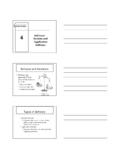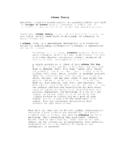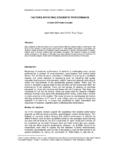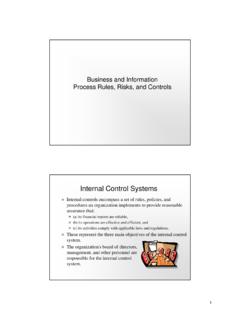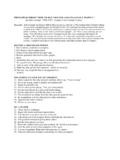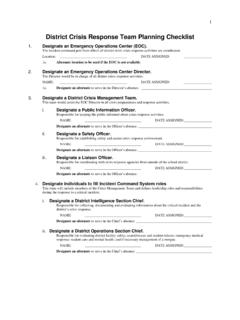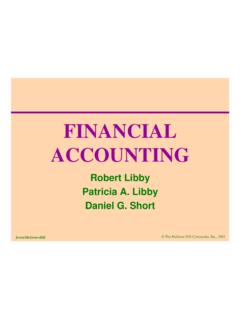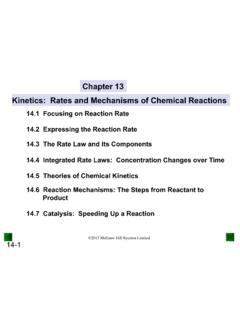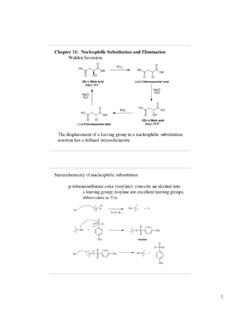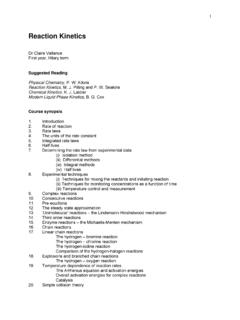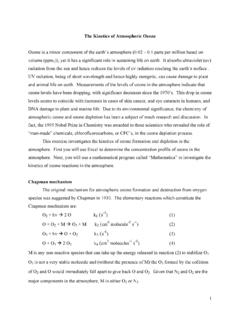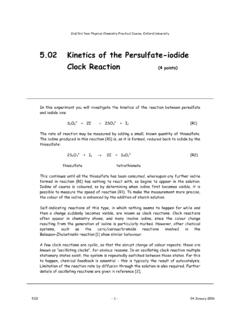Transcription of Chemical Kinetics Reaction Rates - Sacramento State
1 1 Reaction Rates : Reaction Rate:The change in the concentration of a reactant or a product with time (M/s).Reactant Products A B()change in number of moles of BAverage ratechange in timemoles of Bt= = [A]Rate t= [B] t=Since reactants go away with time: Chemical Kinetics2 Consider the decomposition of N2O5to give NO2and O2: 2N2O5(g) 4NO2(g) + O2(g)reactants decrease with timeproducts increase with time32N2O5(g) 4NO2(g) + O2(g)From the graph looking at t = 300 to 400 O =9 10 Ms100s = NO = 10 Ms100s = N O = 10 Ms100s = Why do they differ?
2 Recall:To compare the Rates one must account for the O =9 10 Ms9 10 Ms11 = 51612 Rate NO = 10 10 M14s = 516125 Rate N O = 10 1012Ms = Now they Now they agree!agree! Reaction Rate and StoichiometryaA+ bB cC+ dD[][][][]AB11abCDRatett11cdtt ==== In general for the Reaction :4 The Reaction rate law expressionrelates the rate of a Reaction to the concentrations of the concentration is expressed with an order (exponent).The rate constant converts the concentration expression into thecorrect units of rate (Ms 1).
3 (It also has deeper significance, which will be discussed later)For the general Reaction :For the general Reaction :Rate Law & Reaction OrderaA+ bB cC+ dDxand yare the reactant orders determined from yare NOTthe stoichiometric = k [A] [B] 5 The Overall Orderof a Reaction is the sum of the individual orders:Rate (Ms 1) = k[A][B]1/2[C]2 Overall order:1 + + 2 = = 7/2 or seven halves ordernote:when the order of a Reaction is 1 (first order) no exponent is for the rate constant:The units of a rate constant will change depending upon the overall units of rate are always M/s or Ms 1To find the units of a rate constant for a particular rate law, simply divide the units of rate by the units of molarity in the concentration term of the rate law.
4 Rate (Ms 1) = k[A] 1storder11 Msk(units)sM ==6time (s)Instantaneous rate (tangent line)Y[concentration]Average Rate Xtime = Reaction Ratesconcentration (M)Rules of logarithmslog (1) = 0log (10) = 1log (100) = 2 Log (10x) = xln (1) = 0ln (e) = 1ln (ex) = xlog Ax= xlog Aln Ax= xln AxxxAA Aloglogx logBB B == log(AB) = log A + log BAloglog A log BB = 7 The Reaction of nitric oxide with hydrogen at 1280 C is: Determining Reaction Order: The Method of Initial Rates2NO(g) + 2H2(g) N2(g) + 2H2O(g)From the following data, determine the rate law and rate Rate (M/min)[H2]o(M)[NO]o(M)RunRate(M/min) = k [NO]x[H2]yThe rate law for the Reaction is given by:2NO(g) + 2H2(g) N2(g) + 2H2O(g)Taking the ratio of the Rates of runs 3 and 1 one finds.
5 Rate(3)Rate(1)=xy(3)2 (3)xy(1)2 (1)k [NO] [H ] k [NO] [H ] / / min=xyxyk [ ] [ ] k [ ] [ ]yy[ ][ ]=2 =yy[ ][ ]= = = ()y log 2log 2=y = 1 Rate(1)Rate(2)=xy(1)2 (1)xy(2)2 (2)k [NO] [H ] k [NO] [H ] [ ] [ ] k [ ] [ ]Now that y is known, we may solve for x in a similar manner:124=x1123 x1128 = 11xloglog28 = x = 3 The Rate Law is:Rate(M/min) = k [NO]3[H2]To find the rate constant, choose one set of data and solve:()() ()() ()() M= = 9 Integrated Rate Laws:time dependence of concentrationFor a first order process, the rate law can be written:A products1[A]Rate(Ms )k[A]t = = This is the average rate If one considers the infinitesimal changes in concentration and time the rate law equation becomes:1d[A]Rate(Ms )k[A]dt = =o[A]t[A]0d[A]kdt[A]= where [A] = [A]oat time t = 0and [A] = [A] at time t = tThis is the instantaneous rate Integrating in terms of d[A] and dt:o[A]t[A]0d[A]kdt[A]= o[A]lnkt[A] = kto[A]e[A] =Taking the exponent to each side of the equation.
6 Orkto[A] [A] e =Conclusion:Conclusion:The concentration of a reactant governed by first order Kinetics falls off from an initial concentration exponentially with a first order process:A productsWhenever the conc. of a reactant falls off exponentially, the Kinetics follow first [A] [A] e =A plot of ln[A] versus time (t) is a straight line with slope -kand intercept ln[A]o()ktoln [A] [A] e =Determining the Rate constant for a first order processTaking the log of the integrated rate law for a first order process we find:oln[A] ln[A]k t= 11 Example:The rate of decomposition of azomethane (C2H6N2) was studied by monitoring the partial pressure of the reactant as a function of if the data below support a first order Reaction .
7 Calculate the rate constant for the (s)P (mmHgln (P)0284 of lnP vs. timey = + = (s)ln Pk = Half-Life12 Reaction Half-life:Half-life is the time taken for the concentration of a reactant to drop to half its original [A][A]2=For a first order process the half life (t ) is found mathematically from:[][]0(1) ln Aktln A= +[][]0(2) ln Aln Akt = []0A(3) lnkt[A] = []0A(4) lnkt[A] = []0102A(5) lnkt[A]2 = 12ln certain Reaction proceeds through t first order half-life of the Reaction is 180 percent of the initial concentration remains after 900s?)
8 Step 1: Determine the magnitude of the rate constant, 2ln == =kto[A]e[A] = s 900 so[A]e[A] == the integrated rate law, substituting in the value of k and 900s we find:Since the ratio of [A] to [A]0represents the fraction of [A]othat remains, the % is given by: 100 = a Second Order Process:A ProductsRate = k[A]212d[A]Rate(Ms )k[A]dt = =Integrating as before we find:[][]011ktAA=+A plot of 1/[A] versus t is a straight line with slope kand intercept 1/[A]0 For a second order Reaction , a plot of ln[A] vs. tis not linearnot linear.
9 [][]011ktAA=+Non linearity indicates that the Reaction is not first = k (rate constant)14 Half-life for a second-order reactionUnlike a first order Reaction , the rate constant for a second order process depends on and the initial concentration of a reactant.[][]t011ktAA=+[][]t01AA2= at the half life,Substituting and solving,[]1/ 201tkA=If [NOBr]o= 10-3M, how much NOBr will be left after a Reaction time of 10 minutes?Determine the half-life of this :The reaction2 NOBr (g) 2 NO (g) + Br2(g)is a second order Reaction with respect to NOBr.
10 K= M-1 s-1at []t1 NOBr=[][]t011ktNOBrNOBr=+-1-1( Ms ) (600 s) 10 M + [] 10 MNOBr= [] 10 M = SOLUTION:One can solve for the amount of NOBr after 10 minutes by substituting the given data into the integrated rate law for a second-order Reaction .(Second Order)To determine the half-life for this Reaction , we substitute the initial concentration of NOBr and the rate constant for the Reaction into the equation for the half-life of a second-order 2t= Ms ( 10 M) 160 s=[]1/ 201tkA=16 The ArrheniusEquation:Temperature dependence of the Rate ConstantMost reactions speed up as temperature increases.


